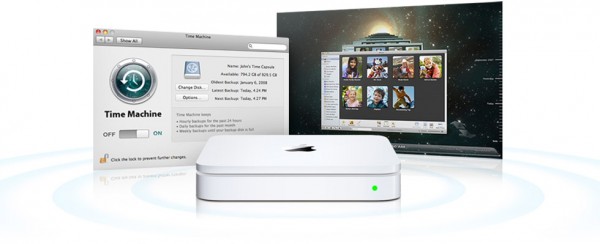
Apple has demonstrated yet again that there are technological frontiers to be explored and innovations to be discovered. Just recently, it has released a new sweet-looking gadget that serves as a Wi-Fi router as well as a backup drive. Though some might think that 499 dollars for 1TB storage is a bit pricey, this is mitigated somewhat by the fact that Apple’s Time Capsule can also double as a router with multiple ports for docking several networking appliances. A lighter 500 GB alternative can be had, anyway, for a smaller 299 price tag.
Apple is famous for its minimalist designs in its products, and Time Capsule is no different. Encased in a slim white exterior with measurements of 7.7 by 7.7 by 1.4 inches, it sports a shiny silver Apple logo on top, with a LED indicator out in the front to signal the device’s status with a glowing green light. A quartet of Ethernet ports, three LAN and one WAN, a printer- and external drive-ready USB port fill up the rear portion of Time Capsule, along with the compulsory reset button, power jack and Kensington security slot. There are no power switches or protruding antennas evident in the gadget’s exterior. The receptors, which are three MIMO antennas, are all housed within the case together with its power supply. The package also includes software in the form of Apple AirPort Utility and Bonjour for Windows in a CD. Peripherals include a power cord and a setup guide booklet. Supposedly, the cables for connecting to its Ethernet and USB ports are supplied with the client devices, so Time Capsule comes without any of these.
As a router, Time Capsule follows the draft 802.11n standard, which makes it compatible with most Wi-Fi capable appliances, even the earlier 802.11 ones. It also operates on dual-band, with a 2.4 GHz and 5 GHz frequency respectively, and can be utilized as an extra access point when connected to an existing network. Managing the router is easy with the bundled AirPort utility app. However, even with its very user-friendly features the software is probably inferior to a web-based device management option, if ever Apple would enable this alternative.
Upon launch of the utility in the computer, the software will automatically locate any Apple Wi-Fi gadgets connected. A basic-looking setup procedure will guide the user with enabling the wireless network, or adding Time Capsule if there is already an existing one. Individuals who would like to have a more specific network installation can do a Manual Setup. Once the utility is up and running, users can view and switch among five main tabs that serve as the network and backup drive settings controls. Using these, a network name can be added, passwords can be created and enabled, or WEP and WPA security measures put up. The controls also provide customizing of MAC address access parameters and Dynamic Host Configuration Protocols, as well as tweaking NAT settings. Time Capsule is equipped with an option for manually selecting the radio bands that the router can receive while operating, thereby blocking out the slower 802.11b from interfering with its signal.
Some other administrative features are the Simple Management Protocol and the ability to do port-mapping. One of the tabs in the utility serves as a printer manager and another, the hard drive manager. With the hard drive tab users can set privileged use for certain hard drives, view stats and even disable network access to any particular drive connected to the device.
Mac and PC users can both make use of Time Capsule in their systems. Macs, though, have the advantage of being its default platform, with Time Capsule being designed with OS X Time Machine in mind. A backup utility in MAC Leopard, it features automatic backup functions on preset intervals not only for files but for the entire OS and its enabled settings. This allows users to reroll the system and return to its previous appearance in any of the backups made. The utility is also designed to work with external hard drives, whether connected directly to the computer or to the base station, the latter being the equivalent of a network attached storage, or NAS device. However, it does lack the redundancy feature and RAID configurability of true NAS devices, and while it can operate wirelessly, it also cannot run music and video files which is a standard in said NAS drives.
Time Capsule has the capacity to run the Time Machine utility in several networked Macs as long as the storage allows. Once full, users have the option to add a single external hard drive via the USB port, or several via a USB hub connected to the same port. By itself, a Windows-based system cannot avail of the Time Machine function, but can utilize the multi-drive feature using a separate app that specifically handles this feature.
Setup-wise, Time Capsule is child’s play. The AirPort Utility is first installed in any of the computers, and as soon as this is done the router will commence assigning IP addresses to the various device systems connected to it. These included both wireless and hardwired platforms, as well as printers and external hard drives. It should be noted, though, that Time Capsule does not enable sending files for printing over the network. This network system works on both PC-based and Mac-based setups, with Macs having the slight advantage in the form of the Time Machine utility.
Upon installation, Time Capsule is enabled as a network drive. Over draft 802.11n, video streaming and file transfers were fast and easy. The router also boasts of an impressive 100-feet maximum range, with a strong, consistent signal that does not degrade the quality of the transfers.
Transferring a 100MB folder requires a mere 21.7 seconds from 50 feet away, with a little more than two minutes to do a 500MB file transfer from the same distance. The 7200-rpm drive took 17 minutes, 6 seconds to finish writing a 10GB folder. It read the same content in 13 minutes, 11 seconds. Its performance is typical of 7200 rpm hard drives.
Apple outdid themselves in coming up with an intuitive, multipurpose router and external drive that does its job with better range and a backup solution for Macs. Barring the full functionalities of a true NAS drive, Time Capsule quite possibly performs all the networking needs of the average home setup.










Comments